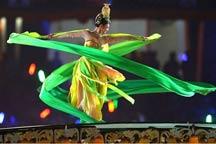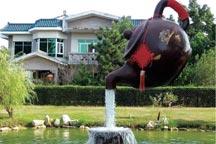In this episode of Travelogue, we'll enter the world of color of the Miao of Guizhou. It's Sister's Festival, a celebration of spring and of love.
Variety of its landscape and diversity of its people. Welcome to Travelogue’s ethnic minority special. If you hear the banging of the drums and the clanking of the silver, you might know that we are in southeastern Guizhou to look at the Miao people. When you look at these people, you might think about their colors, the bright uniforms and the silver, the multicolored rice they eat and the green mountains they live in. I’m Yin and come with me as we explore these people.
There’s an old saying: "The birds nest in trees, the fish swim in rivers, the Miao live on mountains." And indeed, resting on the mysterious mountain slopes of Guizhou are the villages of the Miao – one of the most numerous minority ethnic groups in China。
Today, we’re off to the Guizhou Miao and Dong Autonomous Prefecture, a center of authentic Miao culture.
Here, the wealth of color will surprise you. Dazzling costumes, rainbow colored rice, and glittering jewelry. No doubt there are stories to be told about the vivacious hues used by the Miao.
The local Miao peoples build their villages beside rivers and on mountains. In Leishan County, the communities are compact. The world’s largest Miao village comprises 1000 households. But most are much smaller. Often, a village is a tight-knit community made up of twenty or thirty families belonging to the same clan. People in these parts are mostly farmers or fishermen. They’re quite self-sufficient, from growing their own food to building their own homes. Miao-style houses are wooden and high above ground, standing on stilts to accommodate the hilly terrain. Everything here is in balance with nature.
From stone steps to wooden houses and blue skies, the Miao people worship nature and they believe everything has a special spirit. In this special environment, you can only imagine what types of lives these people lead.
The Miao do not have a written language, but they do have a distinct spoken dialect. Many of their traditions and much of their history have been passed down orally through songs and dances, and in their embroidery. The songs deal with such themes as ghosts and gods, everyday life, love and loss, and the worship of their ancestors. The time to sing is during special ceremonies - weddings, births, deaths, and so on.
This is your typical Miao village, located amongst mountains. The houses here are built on slopes. The house behind me is a typical Miao house. The bottom layer is for livestock and chicken, the second layer for people and the uppermost the storage area. The wooden house blends with the natural environment.
People here also pass down their legends by depicting them in their embroidery, paintings and paper-cuts. The paper-cut is one of the most typically Chinese of folk arts. The women who fashion the intricate designs tend to be very familiar with the stories.
They may look like simple butterflies and birds, and the regular sun. In fact, they are symbols reminding the Miao of their unique history.
The Miao people are clever at using things they find around them to enrich their lives. The bamboo that is found here is shaped into a traditional wind instrument, called the lusheng, and played by the Miao to celebrate a harvest or in worshipping their ancestors. A key part of the instrument is the metal piece that controls the vibrations of different tones. It may seem straightforward enough, but it takes an experienced craftsman to master the shaping of the metal piece. It’s certainly a case of easier said than done.
So how do we control the sound? The low pitch is long and thick and the high pitch is thin and short. The different plates have different notes and different sounds. Let me give you my mic and you can get a better listen. So that’s the deep one. And that’s the thin and short one. See the difference?
Next, we’re on our way south to Biasha, a place that is unique among Miao population centres, for how little it has been affected by the modern way of life. Here, we are welcomed by the sound of the lusheng.
Biasha is hidden away in a forest. The village is filled with towering trees and waterside houses.
The Biasha Miao have an unusual claim to fame – they are China’s last tribe of gunmen. Their ancestors were frontline troops who charged through forests and fought the bears there – all to guard the land where they lived. Still today they preserve their musketeer heritage. In fact, the Biasha are China's last tribe that can legally carry real guns.
These tough-looking guys are priming their weapons. Typically, the women are not allowed to fire the guns. But they make an exception for me. Don’t be scared, folks.
These guys with their guns may be intimidating. But they’re nothing compared with this other guy and his blade. Tradition here is still going strong.
This is, wow. It’s pretty sharp. But I don’t know how I feel about shaving my head with this.
The blade caresses the scalp, and patches of hair fall to the ground. This shave is done without any shaving cream, or even a rinse.
Most of the hair is cut off. All that’s left is a clump in the middle, and that’s twisted into a bun. The bun is a symbol of masculinity and power, and boys get their first haircuts as a rite of passage. It’s a hairstyle that’s existed for thousands of years.
The Miao believe the buns on their heads represent the trees, which to them are holy. A tree is planted whenever a baby is born. Often it will be cut down to make the coffin when that person eventually dies.
Biasha in the Miao language means “place where trees flourish.” Still today, people here observe rituals for worshipping the holy spirits, such as trees, and even a direction. The belief here is that the ancestors of the Biasha Miao traveled to this land from the east during a time of warfare. So they’re worshipping the home of their ancestors in the East. The ceremonies involve climbing a mountain, facing east and burning incense before trees.
No one dares to cut a single branch of these ancient trees.
The bull plays a important part in Miao culture. As a recreational activity, they mimic bull fights. The tree trunks represent charging bulls, which fight each other. It’s nothing like a Spanish bull fight, in which man is pitted against beast.
Next we head to Taijiang, for something called the Sisters festival – an annual celebration of spring and love.
The Sister’s Festival is to the Miao what Valentine’s Day is elsewhere. Girls dress up in their finest, including all their shining silver jewelry. Then they reenact the courting customs that have been observed by the Miao since ancient times.
The girls hurry off to the top of a mountain, where they collect wild flowers and berries. This vegetation is used to dye the glutinous rice a variety of colors for the festival. The rice, the most emblematic item at the festival, may later be given to a suitor.
The plants are picked, dried and ground. Then they’re boiled in water until the color comes out. It’s a process all the women in the family take part in. The colors are all from nature – and the rice is usually dyed blue, pink, yellow and white, representing the four seasons.
This Sister’s Rice is crucial in the courting process, because the rice balls are the tools the girls use to respond subtly to a suitor’s advances. The multicolored glutinous rice is wrapped into small packets with treasures inside, things like leaves, vegetables and nuts, each with a particular meaning. Receiving the rice is like receiving blessings from your Miao neighbors. But then again, who knows, maybe someone here has a secret crush.
Nowadays, the importance of the festival is broader than it used to be. It’s no longer just a courting ritual, but a magnificent celebration of Miao culture. Both locals and tourists gather here on these grand occasions, to enjoy the Sister’s rice.
To celebrate sister’s festival, many people from the villages bring in their best handicrafts and products at this market here, to sell their best products.
At the market there are many old items – all of different colors, and all handmade. You see, sewing and embroidering is believed to be a way of demonstrating respect for one’s ancestors.
It’s very flashy, colorful like the Miao who enjoy all this color, And for sisters festival all of it is in color, the costumes, the rice they eat, and all this is hand embroidered, it’s a little piece of mirror or something.
Silver ornaments feature prominently in a Miao outfit. That’s because silver is believed to be the symbol of light, which dispels evil spirits.
Miao wear the most complicated and finely worked silver headdresses and ornaments. It’s long been the custom for them to decorate themselves from head to toe, with silver. A full set can weigh up to ten kilograms. Since the silver ornaments are a symbol of wealth, a girl’s family will start saving up for her right from the moment she’s born. The most valuable item she’ll ever own is the headdress, which by tradition is decorated with phoenixes. In fact, the patterns on her headdress range from ancient totems to historical legends.
Miao girls begin to learn weaving, embroidery and cross stitching from ages as young as 6 or 7. Each piece is unique, and if you’re good at bargaining, you can get some really great stuff. 30
What’s this guy doing here? You may be used to fishing with a rod, but here they do it with baskets. Hey, I think he’s got something.
Eating is a very social event… families and friends sit at long tables, dressed in their silver gear.
The traditional costumes of different branches of the Miao ethnic group vary, but the craftsmanship is always at the peak of perfection.
The Sisters' Festival brings villagers from many remote areas together – most of them in search of a partner. To me, the array of colors, beautiful costumes, and local traditions makes this a cultural fashion show of sorts.
I feel like I should be wearing sunglasses here because all the girls from the village have put on the best attire, all this silver, to welcome the men from the neighboring village, for the festival. They brought the best food, best clothes, and best song.
The girls sing about their emotions and daily life. It seems like it’s another way of showing off to the men, in addition to their clothing.
And thus begins the festival. The girls give the men the alcohol. And since I have nobody to give it to, want some?
It’s the season of love, and the boys and girls get to know each other ... although very shyly.
The girls have to be careful about which food they choose to give, since each has a special meaning. A hot pepper wrapped inside the cloth represents a flat refusal.
Love is in the air, Miao style.
So these are the items that the girls give to the men. Each represents different things and she says the leaf represents let’s make friends.
They can also choose to give chopsticks. While giving just one is a polite "no-thank-you", giving two means, in effect, "I love you too".
Maybe there’s still a long way to go before they get married. But who knows what the right rice could lead to?
The festival is held every year in April and lasts five days. Apart from anything else, it’s the perfect opportunity just to enjoy the spring weather. The young people sing, dance, eat, and court. As for the married women, they’re more likely to be busy dolling their daughters up in layer upon layer of silver.
You know you are in a Miao village when you hear the banging of the drums and the clanking of the silver.
The unmarried girls dance slowly in a circle in their ornate silver-encrusted costumes. The music is supplied by a big drum in the middle. With the weight of the costumes on the girls and the effects of the alcohol on the village elders, it’s a wonder anyone is left standing after three hours. Yet on and on, round and round they go, shimmering in the sun.
You don’t always find the best performances in fancy theaters with magnificent acoustics. Here in Guizhou, the most brilliant festival can be seen on the mountain plateau, in remote villages, and even beside gurgling water.
In the distance, the drums are still banging, and people are still singing and dancing. But, this ends our journey in southeast Guizhou. I hope this made us better understand the miao people, the vast mountains they live in, and nature itself. I’m Yin and see you next time.
Tips:
The Miao people live in the mountains of Guizhou, in tightly-knit communities.
Miao’s Sister’s Festival occurs on March 15th of the lunar calendar, a celebration of spring and love.
Miao women are often fully dressed in traditional embroidery and silver accessories, which are believed to ward off evil spirits.
 2009 China Central Television. All Rights Reserved
2009 China Central Television. All Rights Reserved

















